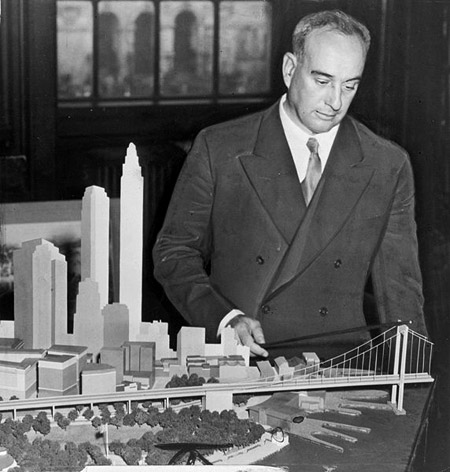Robert Moses and the Modern City
January 31–April 14, 2007
 Robert Moses with a model of his proposed Battery Bridge, 1939. Photograph by C.M. Stieglitz.
Robert Moses with a model of his proposed Battery Bridge, 1939. Photograph by C.M. Stieglitz.The Wallach Art Gallery is joining with two New York City institutions to present a three-part exhibition titled Robert Moses and the Modern City. Coinciding with the section Slum Clearance and the Superblock Solution at the Wallach are Remaking the Metropolis at the Museum of the City of New York and The Road to Recreation at the Queens Museum of Art. The curator of all three exhibitions is Hilary Ballon, an architectural historian and a professor in the Department of Art History and Archaeology.
In Slum Clearance and the Superblock Solution, the Wallach Art Gallery will present for the first time the full scope of Moses's urban renewal program from the 1950s, which was to become a national model. He used Title I money from the federal Housing Act of 1949 to attack the slums and, as he saw it, rescue the city. Moses's strategy involved recapturing the middle class by building affordable housing and enhancing the city's brainpower by providing land to universities for campus expansion. New York University, Fordham, the Juilliard School, Long Island University, and Pratt Institute all were beneficiaries of Title I funding. His housing program encompassed the largest expansion of union-sponsored cooperatives in the city's history, eight in all, including the East River Houses at Corlears Hook, Chatham Green, Chatham Towers, Penn Station South, and Morningside Gardens. Among the objects on view will be brochures issued by the Mayor's Committee on Slum Clearance for twenty-six Title I projects, which illustrate the redevelopment proposal, make the case for clearing a neighborhood, and explain how relocation would be handled; architectural renderings of I. M. Pei's renewal work in the early 1960s at NYU and Kips Bay Plaza; historic photographs and documents showing the process of site clearance and community protests against renewal; and recent photographs by Andrew Moore indicating how Moses projects have been absorbed into the fabric of the city.
Together, the three-part exhibition documents the numerous, diverse, and ambitious projects that Robert Moses spearheaded. Remaking the Metropolis at the Museum of the City of New York (February 1 through May 28) explores the roads that Moses created to make the city center accessible (including the Henry Hudson Parkway, the Cross-Bronx Expressway, and the Triborough Bridge), the institutions that he fostered to enhance the city (including Lincoln Center for the Performing Arts and the United Nations), and the parks that he created and enlarged (including Riverside Park and East River Park). The Road to Recreation at the Queens Museum of Art (February 4 through May 27) documents Moses's massive expansion of the public realm in the 1930s and its connection to a new network of parkways. His reclamation of the shorefront for recreation (Orchard Beach in the Bronx and Jacob Riis Park in Queens) and the construction of monumental swimming pools (such as Astoria, Sunset Park, and McCarren) will be covered.
A major two-day symposium, "Robert Moses: New Perspectives on the Master Builder," will take place at Columbia on March 2 and 3, with the final session to be held at the Museum of the City of New York. Two dozen invited scholars will reexamine Moses's career, delving into diverse aspects of his work, his political ideas, and his relations with other power brokers.
Hilary Ballon, together with Kenneth T. Jackson, the Jacques Barzun Professor in History and the Social Sciences at Columbia, is the coeditor of the book that accompanies the exhibitions, Robert Moses and the Modern City: The Transformation of New York, published by W. W. Norton. The book features seven essays by leading scholars, the first comprehensive catalogue of Moses's built works as well as unexecuted projects, hundreds of archival photographs, and newly commissioned photographs by Andrew Moore.
Special exhibition website: Robert Moses and the Modern City ![]()
The exhibition at the Wallach Art Gallery is made possible by an endowment established by Miriam and Ira D. Wallach and by project funding from the Herbert H. Lehman Center for American History at Columbia. Funding for the book came from the National Endowment for the Arts, the New York State Council on the Arts, Furthermore: a program of the J. M. Kaplan Fund, and the Graham Foundation for Advanced Studies in the Fine Arts.


